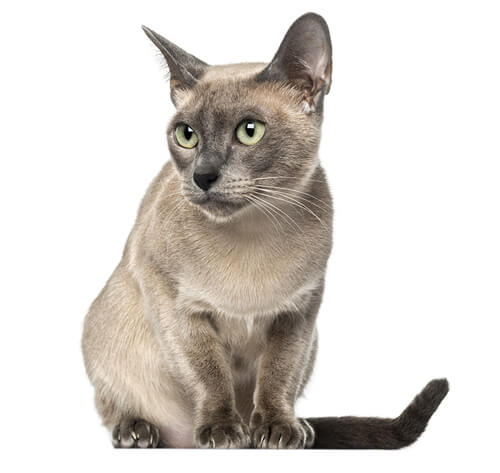
The colourful personality of the Tonkinese is one of the breed’s greatest attributes. Muscular and active, with a sense of humor, this feline enjoys playing, climbing and whizzing by at warp speed. With her warm, loving personality, the Tonk craves human attention and shouldn’t be left alone for long periods. This is a lap cat that prefers playmates, including children, other cats and cat friendly dogs.
DID YOU KNOW? The Tonkinese, like her ancestral breeds, the Burmese and Siamese, becomes darker as she ages. A pointed Tonkinese is born white, with the point colours beginning to develop when kittens are a few days old. They do not develop their full, rich colours for several years
The need-to-know
- Highly active and inquisitive cat
- Sociable and dependent cat
- Somehow talkative cat
- Average build cat breed
- Requires grooming once a week
- Outdoor cat
- Great family cat
Personality

The Tonkinese cat breed has the same affectionate, friendly nature, as its close relatives the Burmese and Siamese. These cats are very people-orientated and make ideal family pets – they are said to be very inquisitive and intelligent. They can be trained to do tricks and require toys and games for amusement. They love company and if they are to be left alone for long periods of time a companion is a necessity. They are quite vocal and will chatter happily to you and follow you around.
History and Origins

Country of Origin: USA
Other Names: : Golden Siamese
The Tonkinese cat breed is the result of crossing a Siamese cat with a Burmese cat and, therefore, displays characteristics from both breeds. Mostly ignored when they were first developed as 'Golden Siamese' cat in America 1950s, it was not until the 1960s when they reappeared as Tonkinese that their popularity grew.
Nutrition and Feeding

Every cat is unique and each has their own particular likes, dislikes, and needs when it comes to food. However, cats are carnivores and every cat must obtain 41 different and specific nutrients from their food. The proportion of these nutrients will vary depending on age, lifestyle and overall health, so it's not surprising that a growing, energetic kitten needs a different balance of nutrients in her diet than a less active senior cat. Other considerations to bear in mind are feeding the right quantity of food to maintain 'ideal body condition' in accordance with feeding guidelines and catering to individual preference regarding wet or dry food recipes.
Other Information

Health and common issues
Currently there are no specific inherited problems reported with the Tonkinese cat breed. As with all cats, Tonkinese cats benefit from protection against disease through vaccination and need regular parasite control and annual veterinary health checks.
Best cat breeds for children
While this breed is not widely recognised as one of the best breeds for children, all cats are different and with the proper familiarisation may still be able to live with children.